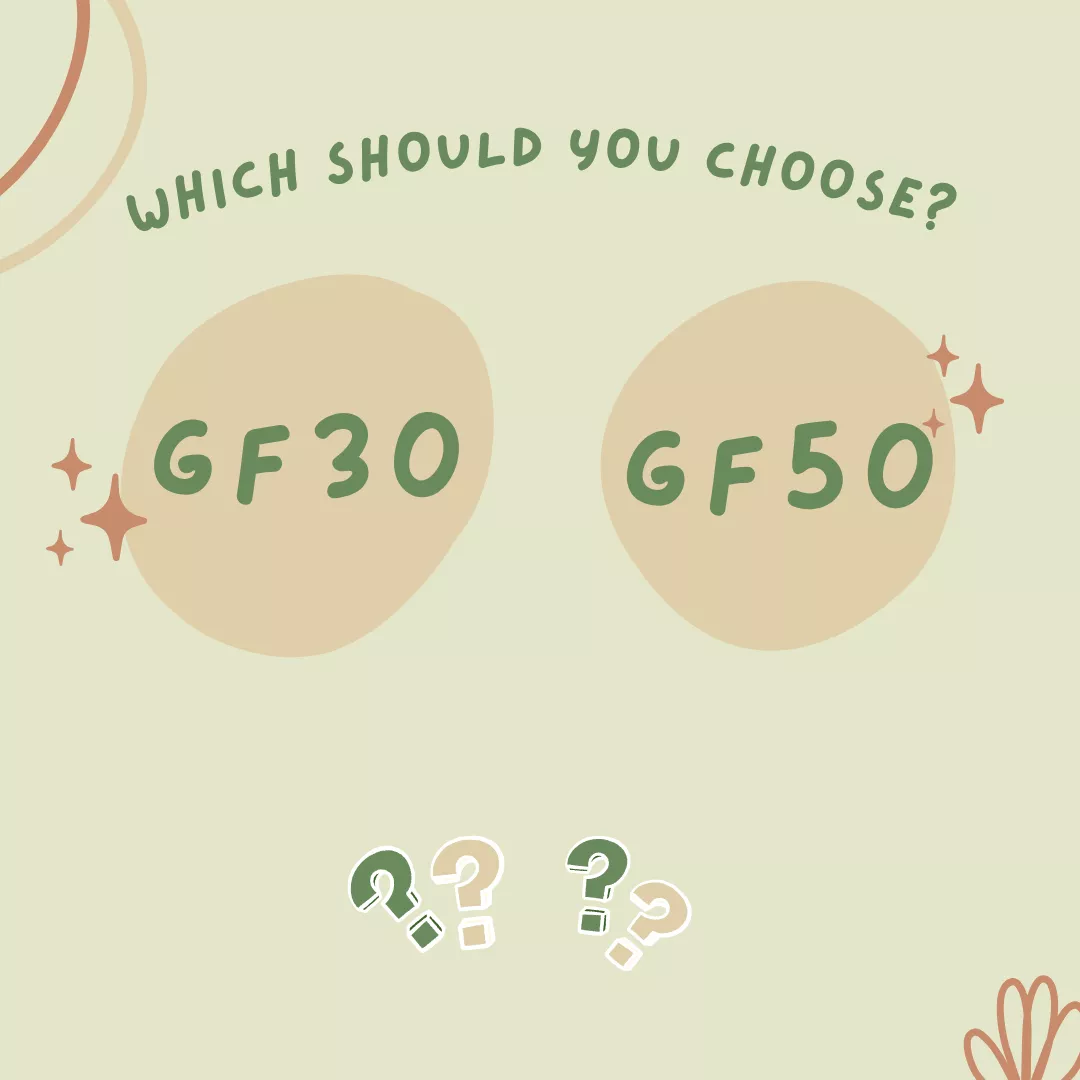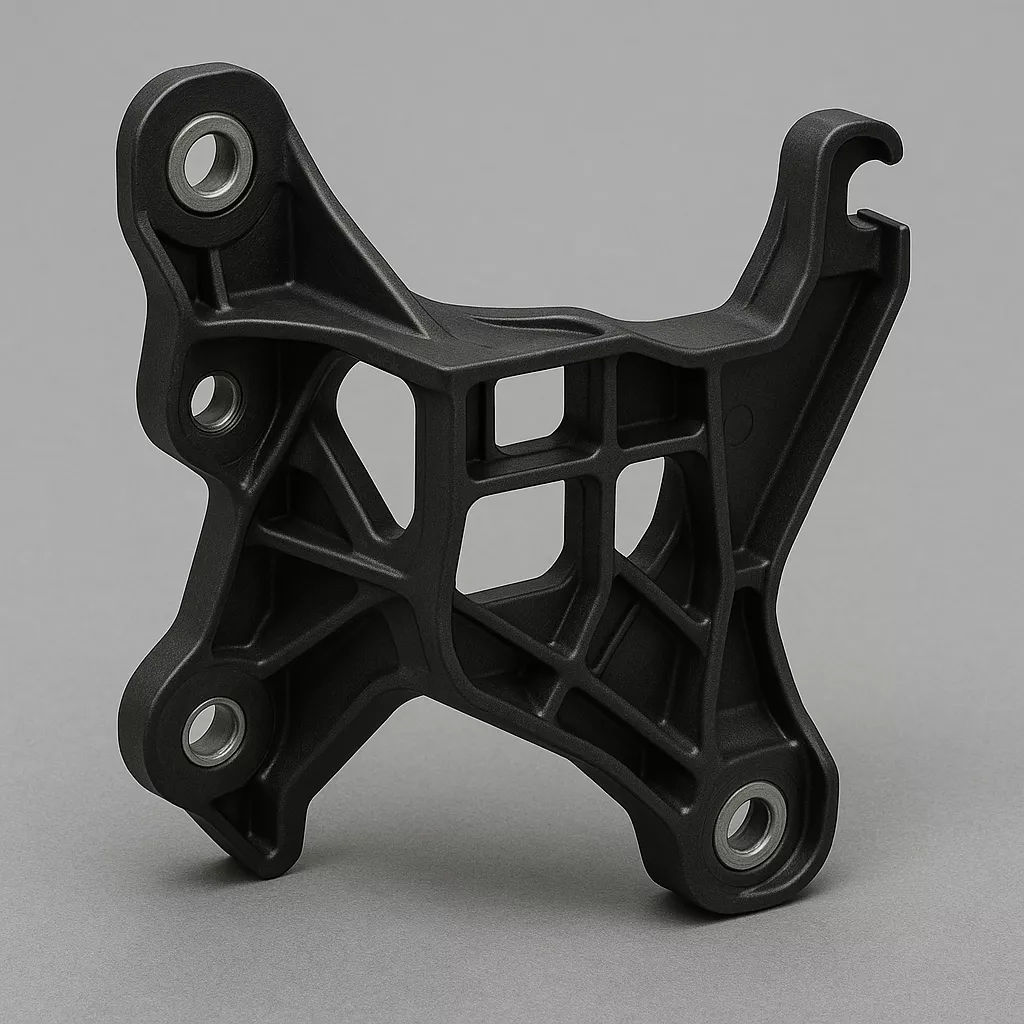Glass filled nylon is one of the most widely used reinforced engineering plastics, created by combining nylon (PA6 or PA66) with glass fibers. This reinforcement dramatically improves stiffness, strength, and thermal stability—allowing nylon to replace metals in demanding applications.
However, not all glass-filled nylons are the same.
A common question from engineers and buyers is: what's the difference between 30% and 50% glass fiber content, and when should you choose each?

How Fiber Content Affects Glass Filled Nylon Properties (30% vs 50%)
30% Glass Fiber Nylon (PA6 GF30 / PA66 GF30)
- Balanced strength and toughness for general engineering use.
- Reduced shrinkage while maintaining moderate flexibility.
- Better mold flow, making it suitable for complex or thin-wall parts.
- Applications: appliance housings, automotive clips, hand tools, and office furniture.

50% Glass Fiber Nylon (PA6 GF50 / PA66 GF50)
- Extremely high stiffness and dimensional stability—often used for lightweight metal replacement.
- Higher tensile and flexural strength, but more brittle.
- Requires higher injection pressure and mold durability due to the abrasive fibers.
- Applications: engine covers, brackets, structural supports, and precision components requiring rigidity.

👉 Key takeaway: GF30 is the“all-rounder”for balanced performance; GF50 is for high-load, structural parts where rigidity outweighs impact resistance.
Property Comparison: PA66 GF30 vs PA66 GF50 (ISO Standards)
| Property | Test Standard | PA66 GF30 | PA66 GF50 |
|---|---|---|---|
| Tensile Strength | ISO 527 | ~190 MPa | ~225 MPa |
| Flexural Modulus | ISO 178 | ~8,600 MPa | ~15,000 MPa |
| Impact Strength (Notched Izod) | ISO 180-1A Charpy, 23℃ | ~13 kJ/m² | ~14 kJ/m² |
| Heat Deflection Temperature @ 1.8 MPa | ISO 75, 1.8Mpa | ~250 °C | ~250 °C |
| Density | ISO 1183 | 1.38 g/cm³ | 1.58 g/cm³ |
| Mold Shrinkage | - | 0.3–0.5 % | 0.1–0.3 % |
Values are representative ranges and may vary by formulation.
Advantages of Glass Filled Nylon in General
- Mechanical Performance: high tensile strength, flexural modulus, and creep resistance.
- Thermal Resistance: continuous service temperature up to 100 – 150 °C.
- Chemical Resistance: excellent performance against oils, fuels, and lubricants.
Limitations of Glass Filled Nylon Materials
- Brittleness increases with higher fiber content.
- Tool wear due to fiber abrasion → higher tooling cost.
- Anisotropy and warpage caused by fiber orientation during molding.
Case Study – Automotive Bracket Replacement
A Tier-1 automotive supplier sought to replace a heavy metal bracket with a lighter polymer alternative. By switching to PA66 GF50, the project achieved:
- 45% weight reduction compared to metal,
- Compliance with ISO 527 tensile requirements, and
- 18% cost savings per part after tooling optimization.
Although the mold required higher pressure and wear-resistant steel, the final design met all structural and dimensional stability goals.

🔗 Read more: Top Plastics for Metal Replacement in Manufacturing
Metal Replacement Nylon Polymers
Design & Processing Guidelines for Glass Filled Nylon
To ensure best molding results and mechanical consistency:
- Maintain uniform wall thickness to avoid stress concentration.
- Use generous radii at corners to prevent cracking.
- Increase injection pressure and mold temperature as fiber content rises.
- Control moisture content carefully—both GF30 and GF50 are sensitive to moisture uptake.
💡 Tip: For more insights, see Impact-Modified Nylon with Glass Fiber.
How to Choose Between 30% and 50% Glass Filled Nylon
When selecting between 30% and 50% glass filled nylon, the right choice depends on your application requirements:
| Requirement | Recommended Material | Reason |
|---|---|---|
| Balanced stiffness and toughness | PA6 GF30 / PA66 GF30 | Easier processing and good impact strength |
| Maximum rigidity and dimensional stability | PA6 GF50 / PA66 GF50 | Best for structural or load-bearing parts |
| High toughness + stiffness | Custom hybrid (GF + impact modifier or mineral) | Optimized for strength, impact, and stability |
By matching the glass fiber content to your design goals, you can avoid over-engineering (and overspending) while ensuring consistent reliability.
FAQ – Common Questions about Glass Filled Nylon
Q: What is the cost difference between 30% and 50% glass filled nylon?
A: Generally, GF50 is more expensive due to higher fiber content and increased tooling wear. However, in structural applications, it can still reduce overall costs by replacing metal components.
Q: How heat resistant is glass filled nylon?
A: Both PA6 and PA66 grades with 30% or 50% glass fiber can withstand continuous service temperatures of 100–150 °C, depending on formulation.
Q: Is glass filled nylon recyclable?
A: Yes, glass filled nylon can be reprocessed, but mechanical properties may drop slightly after multiple cycles due to fiber length reduction.
Q: What are the molding challenges with GF50 compared to GF30?
A: GF50 requires higher injection pressure, stronger tooling, and careful moisture control. GF30 flows more easily, making it better for complex geometries.
Q: Can glass filled nylon be used in food-contact or medical applications?
A: Standard GF nylons are not FDA-compliant, but special medical- and food-grade formulations exist. Always check certifications before selecting materials.
Q: How does glass filled nylon compare to carbon fiber reinforced nylon?
A: Carbon fiber grades are lighter and stiffer, but also more expensive. GF nylon is more cost-effective for mass production.
Alternatives if GF Nylon Isn't Ideal: Choosing the Right Glass Fiber Content
At first glance, it might seem like a higher glass fiber percentage always means better performance. In reality, more fibers often mean more stiffness, but also less toughness. For example, 50% GF nylon offers excellent rigidity but can crack more easily under sudden impact compared to 30% GF nylon. That's why the “best” choice depends on your application requirements:
- Do you need a balance of strength and impact resistance? → GF30 could be the right fit.
- Do you need maximum rigidity and dimensional stability for structural parts? → GF50 may be the solution.
- Do you need both stiffness and toughness? → We provide tailored solutions, such as combining glass fiber with impact modifiers or mineral fillers, to achieve the right balance.
Final Thoughts
Selecting between GF30 and GF50 nylon is not just about fiber content—it's about understanding how stiffness, impact, and processability interact in your design. At All Around Polymer (All Around Compounding Co., Ltd.), we specialize in custom glass fiber formulations, combining reinforcement, modifiers, and mineral fillers to achieve the perfect balance of strength, cost, and dimensional stability.
Instead of guessing, reach out to our team. We'll evaluate your project's performance goals and recommend whether GF30, GF50, or a custom formulation is the smarter, more cost-effective option.
👉 Read more:
Complete Guide to Long Fiber Reinforced Nylon
High-Performance Reinforced PA: Solutions for Superior Strength and Dimensional Stability

